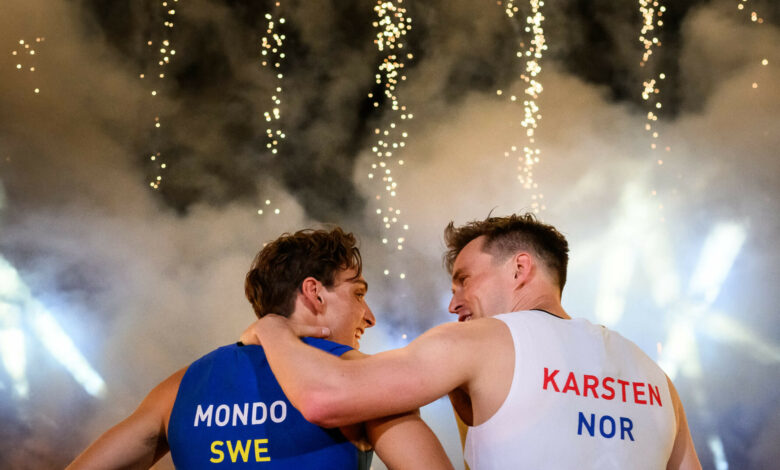The numbers that show the depth of the men’s 100m sprint – and why Mondo Duplantis is almost there

You probably start to get a little bored once you’ve won Olympic gold and broken your own world record.
That, at least, is the simplest explanation for the 100-meter match between Mondo Duplantis and Karsten Warholm on a warm evening in early September in Zurich, the night before the Weltklasse Diamond League match.
Neither athlete is a sprinter, and it was less than a month ago that they competed in the Olympic final: Duplantis jumped 6.25 meters to win in Paris. It was his ninth world record (he has since jumped 6.26 meters, good for world record number 10) and his second Olympic title. It makes him the first man to retain the Olympic title in pole vaulting since Bob Richards in 1956.
Warholm had won the combination of Olympic gold and world record in Tokyo three years earlier, running the 400-meter hurdles in 45.94. Unlike Duplantis, Warholm did not leave Paris as an Olympic champion, but took silver behind American Rai Benjamin.
Duplantis, a notoriously modest winner, made a joke of it in the social media buildup leading up to the race. An Instagram poll showed that two-thirds expected Duplantis to win, to which Warholm asked if he was “buying votes” and Duplantis replied that fans “just picked gold over silver.”
The favouritism continued in the build-up to the race, with fans stretching out along the home straight and handing out A4 cards with Duplantis’ face on one side and Warholm’s on the other. There were more cheers for Duplantis and more of his face was held up when the commentator asked who would win.

(Fabrice Coffrini/AFP via Getty Images)
They didn’t really need to be here — two of the best athletes in track and field looking to outdo each other in a neutral event. The idea was born more than a year ago, in Monaco, as the pair prepared for the Diamond League event. That didn’t mean it wasn’t appealing.
Similar PBs and different strengths made for a competitive race, in theory. Duplantis says he trains “like a sprinter,” jumping just once a week, and his pole vaults are — essentially — 45-meter sprints.
Warholm benefits from being a better and more frequent block starter and has superior speed endurance, even if his style is to start hard. He says he sent videos of his block starts to Usain Bolt for some tips, while Duplantis did some blockwork with the USA’s Fred Kerley.
Top athletes were divided when asked for their predictions. Botswana’s Olympic 200m champion Letsile Tebogo and American Masai Russell, Olympic 100m hurdles champion, both backed Duplantis for his top speed.
World and Olympic 100-meter champion Noah Lyles and 1500-meter silver and bronze medalists Josh Kerr and Yared Nuguse thought Warholm would win because of the block start.
As it turned out, Duplantis’ blocking was phenomenal. He reacted quicker than Warholm, being faster in his first three steps and faster through his acceleration phase. Duplantis led from the gun and passed in 10.37, a tenth faster than Warholm, with a big enough margin to turn his head at the finish and stare at the Norwegian.

(Fabrice Coffrini/AFP via Getty Images)
Before the race, Duplantis said his greatest strength “used to be my closing speed, but I’m much more explosive now than I was in high school. I think I still have really good top speed and sprint endurance.” He was right.
Neither had competed at the distance for years — Duplantis, 24, hasn’t since high school, and Warholm, 28, hasn’t since 2016. Duplantis emphasized how “completely different” and “mature” his body and training regimen are now. Eight years is a lifetime in track and field. As recently as 2016, Usain Bolt was still competing.
Seven years after his retirement, the Jamaican is still king. He holds the three fastest 100m times, four of the seven fastest 200m times and world records in both distances that have stood for 15 years. Sprinting has seen nothing like those four days in Berlin at the 2009 World Championships when Bolt ran 9.58 and 19.19.
Bolt may have been too good, unintentionally. The 100m has always been the showpiece of athletics, but in an era of precision-designed tracks and improved shoe technology, world records have been broken.
Of the Olympic distance track events, only the 1500-meter world record (Hicham El Guerrouj from 1998) has outlasted Bolt’s 100- and 200-meter crowns. Among men, the 110- and 400-meter hurdles, the 800-, 1500- and 3000-meter steeplechase all hold world records that athletes are in real danger of breaking.

Usain Bolt’s 100m record of 9.58 has stood since 2009 (Mark Dadswell/Getty Images)
Meanwhile, few come close to matching Bolt’s times. No one has run faster than 9.76 since Justin Gatlin in 2015, and the fastest male 100m time in each of the last seven years has been run by a different athlete.
Just look at the world record and you fall into the misconception that the men’s 100m sprint is getting worse. The reality is the opposite.
The progression of Olympic standard times proves that. It crept from 10.21 in 2008 (Beijing) to 10.16 in Rio eight years later. Then sprinters had to run 10.05 to qualify for Tokyo in 2021 and 10.00 was the limit in Paris.
Part of that was because World Athletics wanted to move to a 50-50 split, with half the athletes qualifying for world championships via world rankings and the other half via times. But look at the number of times under 10 seconds (the hallmark of a truly elite male sprinter) and there are clear improvements.
From early 2008 to late 2016 (the Bolt era), an average of 55 sub-10-second 100m runs were recorded each year, peaking at 91 in 2015, a year in which the World Championships were held.
During that period, approximately 18 unique athletes per year managed to exceed 10 seconds (a peak of 27 in 2015).
Post-pandemic, those numbers have exploded, far exceeding Bolt’s heyday — at least 75 sub-10s per year since 2021, with 102 last year. There have been 24 athletes under the threshold in 2021, 30 in 2022, 40 last year and 35 so far in 2024. Even as the sprint ceiling has remained stagnant, the floor has risen dramatically.
The Paris Olympics hosted the most competitive 100m championships ever. The final was the hardest to qualify for, the first time that a time under 10 seconds did not guarantee a place, and the final was the most exciting in Olympic history.
There was only a difference of five hundredths between Noah Lyles and Kishane Thompson for gold, but only 0.12 seconds separated first (Lyles) and eighth (Oblique Seville).

Paris saw the closest men’s 100m final in Olympic history (Richard Heathcote/Getty Images)
Duplantis’ and Warholm’s times were in a different stratosphere than that final. Neither would have survived the heats in Paris — 10.16 was the slowest qualifying time, and of the 68 100m heats, 52 athletes ran faster than Duplantis and 59 faster than Warholm.
Granted, Duplantis said he only cared about winning, not the time, and Warholm called it a “good old-fashioned pissing match.” This was evident in the boxer-style walkouts, with Warholm in a red dress and Duplantis in blue, with strobe lights on his back.
The bragging rights were further enhanced before the race, as the loser was told he would wear the other’s national vest the following day in the Weltklasse Diamond League. A big deal considering the rivalry between Norway and Sweden.
Amid all the spectacle, it was easy to remember how athletes moved through events in the past. This summer marked 40 years since Carl Lewis won gold in the 100m, 200m and long jump at the 1984 Los Angeles Games.
This feat has now become virtually impossible due to increased participation and professionalization worldwide and the increased specialization of athletes that David Epstein spoke about in his 2014 Ted Talk.
Neither Duplantis nor Warholm would compete in a second event (except perhaps Warholm in the 400m relay) due to the risk of injury and the negative impact it would likely have on their main goal.
Wednesday’s 100m race in Zurich also proved the absurdity of a YouGov poll of August 10, 2024which was conducted during the Paris Olympics. 27 percent of Britons believed they could be an Olympian in 2028 if they started straight away, while six percent were confident they could do so in the 100 metres (17 percent if they went into isolation only for 18-24 year olds).
Perhaps it was misplaced belief or unserious reactions, but it showed the British perspective on the 100m. Britain had Daryll Neita in the women’s 100m final, who finished fourth, but no representation in the men’s final. Perhaps the respondents hadn’t watched it.
Even if Bolt’s record shows no signs of fading in the near future, the depth of men’s sprinting is astonishing. Iron sharpens iron, as the saying goes. More and more sprinters are getting faster, and eventually the 9.76-second ceiling will be broken.
(Top photo: Fabrice Coffrini/AFP via Getty Images)




